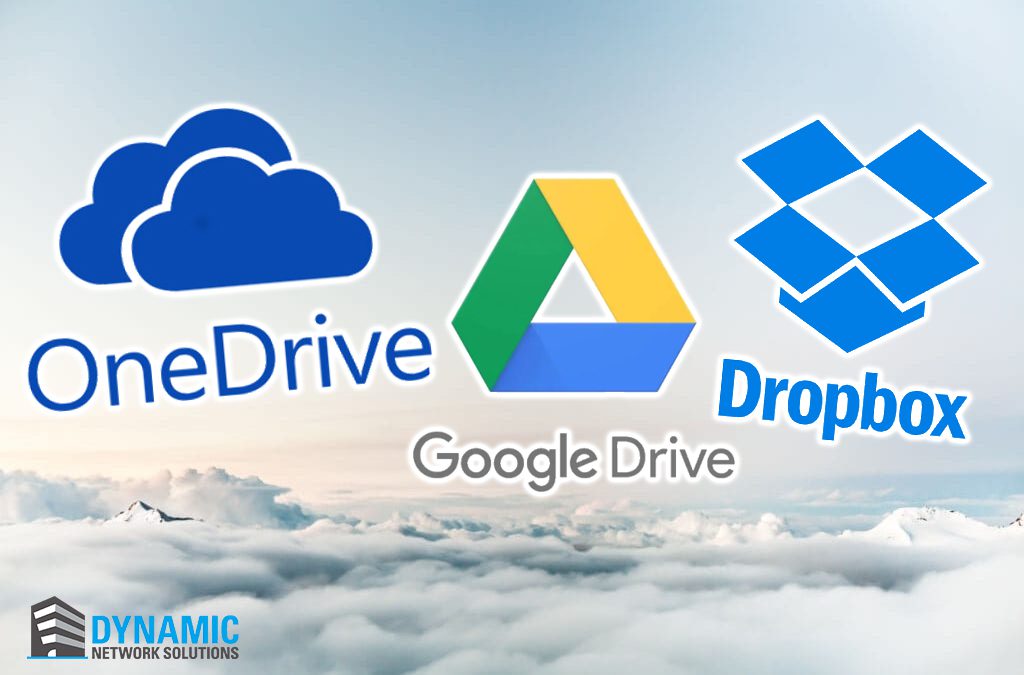Cloud Storage Showdown: OneDrive vs. Google Drive vs. Dropbox
Cloud storage is becoming increasingly popular for individuals and businesses alike. In this cloud storage showdown, we’ll compare three of the most popular cloud storage services – OneDrive, Google Drive, and Dropbox – and discuss the benefits, best practices, and key considerations for using cloud storage.
Benefits of Cloud Storage:
- Access files from anywhere, on any device
- Collaborate with others in real-time
- Automatic backups and version control
- Scalable and flexible storage options
- Reduced reliance on physical storage devices
OneDrive vs. Google Drive vs. Dropbox Base Costs:
- OneDrive: integrates with Microsoft Office, offers secure sharing options, 5GB free storage, paid plans start at $1.99/month
- Google Drive: integrates with Google Workspace, offers powerful search capabilities, 15GB free storage, paid plans start at $1.99/month
- Dropbox: easy-to-use interface, offers team collaboration tools, 2GB free storage, paid plans start at $9.99/month
Comparing Microsoft OneDrive, Google Drive and Dropbox: Pros and Cons
Each cloud storage service has its own strengths and weaknesses.
OneDrive’s Pros: Microsoft OneDrive offers several advantages, including:
Mobile Collaboration: With the OneDrive mobile app, businesses can upload, edit, and share files on-the-go, boosting productivity without adding expensive overhead costs.
Integrated Ecosystem: OneDrive seamlessly integrates with Microsoft Office apps such as Word, PowerPoint, and others, providing users with a web version as well as a desktop version for online and offline work.
File Revision History: OneDrive retains file revisions for 30 days, allowing users to undo changes made within that timeframe. With 365 OneDrive, up to 500 revisions are available for any file.
OneDrive’s Cons: Microsoft OneDrive also has a few drawbacks, including:
Lack of Third-Party Integration: At present, OneDrive for Business does not support third-party app integrations, preventing users from syncing their business accounts with non-Microsoft apps such as calendars, message boards, and project management platforms.
Limited Data Protection: While Microsoft protects against infrastructure threats, such as hardware and software failure, power outages, and natural disasters, it does not protect user data from human error, illegitimate deletion, program/sync errors, malicious insiders, malware, and ransomware.
Google Drive’s Pros: Google Drive offers a number of benefits, such as:
Effortless Collaboration: Google Drive’s real-time editing and sharing features make personal and professional collaboration a breeze, allowing users to share documents, spreadsheets, and other content with colleagues, family, and friends easily.
Intuitive User Interface: Google Drive’s user-friendly interface, including its efficient built-in search engine, makes it incredibly easy to use.
File Revision History: Google Drive keeps file revisions for 30 days, enabling users to rollback changes, intended or otherwise, within that window. Google Drive retains up to 100 revisions for any file.
Google Drive’s Cons: Google Drive has a few limitations, including:
Limited Collaboration: Sharing and real-time editing are not accessible to non-Google account holders, requiring permission from the recipient before they can view the content, and no editing is permitted.
Limited Data Protection: While Google provides best-in-class security against infrastructure threats, it does not protect user data from human error, illegitimate deletion, program/sync errors, malicious insiders, malware, and ransomware.
Dropbox Pros: Dropbox offers several advantages, including:
Seamless integration: With apps available for nearly every operating system, Dropbox’s extensive experience in cloud storage ensures widespread accessibility across all devices and operating systems.
Versatile collaboration: Users can share files via email links or URLs, with the option to choose between read-only and editing permissions. Business subscribers can set expiry dates and password protection, and receive notifications of file access and actions taken.
File revision history: Dropbox Professional and Business accounts can recover versions of files within the past 180 days, with a complete version history of each edited file in that period.
Digital signatures enabled: Paid subscribers can e-sign contracts and other legal documents, with the exception of the Professional+e-Sign plan, which offers unlimited signatures for $24.99/month in addition to the standard Professional package.
Disadvantages of Dropbox: Dropbox has some limitations, which include:
Limited free storage: The 2GB storage limit for free users is inadequate for large file storage, compared to the 5GB available with Microsoft OneDrive or 15GB with Google Drive.
Relatively expensive paid subscriptions: Dropbox’s storage limits are not the best value proposition compared to OneDrive or Google Drive.
Security concerns: File transfers utilize standard SSL/TLS security, which is effective but not as advanced as 256-bit AES encryption.
Best Practices for Cloud Storage:
- Use 2-Factor Authentication (2FA): This adds an additional layer of security to your account and requires you to provide a second factor, such as a code sent to your phone, in addition to your password [1].
- Encrypt sensitive data before uploading: Encryption ensures that even if someone gains access to your data, they will not be able to read it without the encryption key [1].
- Use strong, unique passwords: A strong password should be at least 12 characters long and include upper and lowercase letters, numbers, and special characters [2].
- Increase speed and redundancy of important files by setting them to mirror vs. simply stream: Mirroring creates an exact copy of a file, which can be accessed much faster than streaming. Additionally, if one copy becomes corrupted or lost, you still have another copy available [1].
- Set file and folder permissions carefully so as to not accidentally share information with unintended parties: This can be done by assigning different levels of access to different users, such as read-only, read-write, or administrator [3].
- Keep track of storage usage and delete unnecessary files to simplify access and avoid unnecessary fees: This is especially important for businesses that use cloud storage to store large amounts of data [1].
Key Considerations:
- Security and privacy concerns
- Cost of storage and potential data overage charges
- Integration with other software and services
- Available storage and scalability options
- Ease of use and user interface
Conclusion: In conclusion, choosing the right cloud storage service can be a game-changer for individuals and businesses alike. Each of the services we’ve discussed – OneDrive, Google Drive, and Dropbox – has its own unique benefits, best practices, and key considerations to keep in mind. If you’re still unsure which service is right for you, contact us at LogicFortress for expert guidance and advice.




